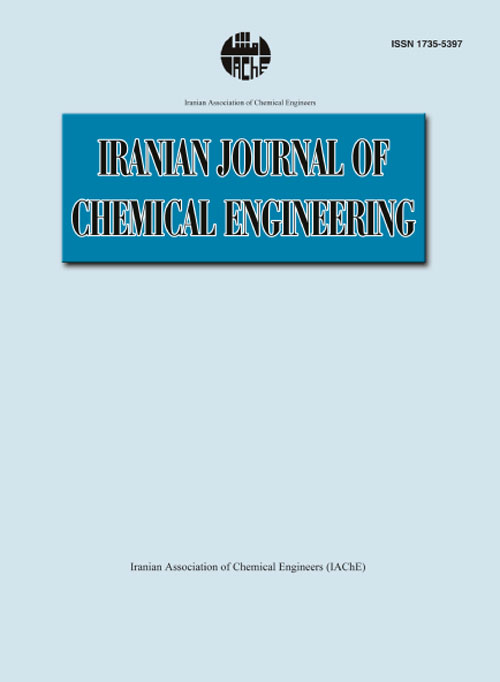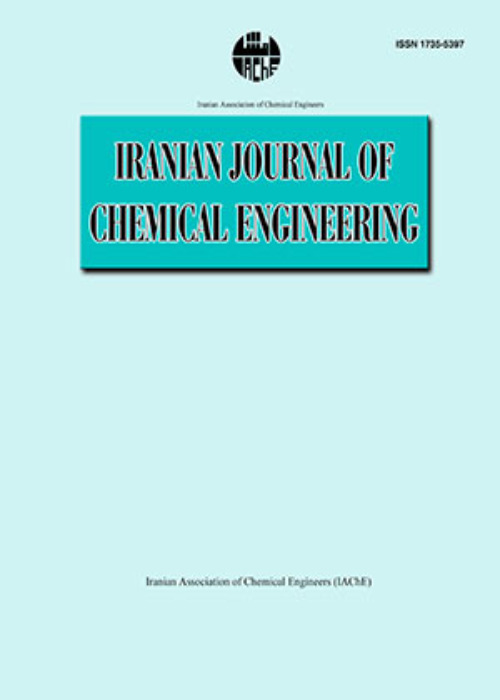فهرست مطالب

Iranian journal of chemical engineering
Volume:10 Issue: 3, summer 2013
- تاریخ انتشار: 1393/06/30
- تعداد عناوین: 7
-
-
Page 3In the present study, the main focus was on plasma pyrolysis and gasification of organic waste, specifically polyethylene and cotton waste and exploring the energy recovery possibilities from the gases obtained after the plasma pyrolysis and gasification. In pyrolysis the gases formed are Syn gas (H2 + CO), CH4, higher hydrocarbons along with soot particles. The waste is disintegrated using thermal plasma (which is generated using graphite plasma torch) in oxygen starved environment (pyrolysis) and also in partial oxidation condition (gasification). Experiments have been carried out by varying pyrolysis chamber temperature from 5000C to 7000C and polyethylene and cotton are fed into the pyrolysis chamber. It has been observed that plasma pyrolysis of polyethylene in the temperature range of 500 to 700 0C yields H2 as main component around 30-40% volume basis along with CO, CO2, CH4, C2H6, C2H4, C2H2 and soot particles whereas pyrolysis of cotton, on the other hand provides less H2 around 15-20 %. However, it has also been observed that in plasma gasification H2, CO, CH4 content in the exhaust gases reduces to some extent (2-5%). The theoretical and experimental energy recovery comparisons have also been carried out.Keywords: Energy Recovery, Hydrogen, Polyethylene, Cotton, Thermal Plasma
-
Page 14In this work a simplified model based on perturbation theory is presented for prediction of activity coefficient of amino acids and electrolytes in aqueous electrolyte solution. In comparison with previous works, in this model a new hard sphere equation of state has been utilized as a reference term while other interactions such as charge-charge, charge-dipole, dipole-dipole and dipole-induced dipole have been considered as perturbation terms. For simplification, solvent has been considered as dielectric continuum. Finally, aqueous electrolyte solutions containing amino acids have been modeled just using two adjustable parameters. The results have been compared with similar models and it is shown that new hard spheres equation of state shows an improvement in accuracy of the model.Keywords: Activity Coefficient, Perturbation Model, Amino acid, Peptide, Hard Sphere
-
Page 27Coal is widely used in activated carbon production as an important precursor. Product properties of the coal gasification are as functions of coal type and operating conditions, so processing of any coal to produce activated carbon follows a different approach. In this study, a coal sample from Goltoot mine, one of the important coal mines in Iran was selected. Pre-oxidation, charring and activation of the coal were carried out in a rotary kiln reactor at different operating conditions. The results showed excellent potential of the coal for producing high quality activated carbon with controllable pore structure. Steam activation of the char at temperature 860°C for 3 hr produced an activated carbon with surface area around 1300 m2/gr and yield %20 wt. The effects of operating conditions such as activation time and temperature and reactant gas type were studied to develop the tailored properties in the product.Keywords: Activated Carbon, Coal Activation, Iranian Coal, Pore Size Distribution, Rotary Kiln Reactor
-
Page 39Cadmium is a hazardous non-biodegradable material that enters the food chain. In this study, the removal of cadmium from aqueous solutions by Canola residues (a natural biosorbent) was investigated. The effect of parameters such as contact time, pH, cadmium concentration and adsorbent dose were evaluated, the results showed that increasing of pH, contact time and adsorbent caused increasing of efficiency of removal cadmium from aqueous solutions. A comparison between non-linear and linear of estimating the isotherm and kinetic parameters was discussed. The results confirmed that the non-linear method was a more efficient method to gain isotherm and kinetic parameters.Keywords: Canola residues, Aqueous Two Phase, Biosorption, Biokinetics
-
Page 51In this study, CuO/CeO2 Nano-catalyst was successfully prepared by impregnationultrasound assisted methods and used for selective oxidation. This catalyst has been characterized by means of XRD, BET, FTIR and SEM. The results show that CuO/CeO2 is nanosized (rSEM < 100 nm) and BET surface area of tested materials was in the range of 45–76 m2/g. CuO is the active phase for selective CO oxidation, even operating at a gas hourly space velocity as high as 30000 h-1. The catalysts CuO/CeO2 exhibit the CO conversion 100% in the wide temperature range of 100–120°C, and with the CO oxidation selectivity greater than 86% at 100 ◦C.Keywords: Nanocatalyst, Selective Oxidation, Copper Oxide Ceria, Ultrasound Energy
-
Page 60It was reported that the industrial application of Sub-Molten Salt method for production of potassium titanate from ilmenite concentrate is limited by feed particle size. Therefore, the objective of this study was to develop an improved approach for decomposition of ilmenite under industrial conditions. Using an ilmenite concentrate from Kahnooj Titanium Complex, experiments were performed at different conditions designed by the Response Surface Methodology (RSM) method. From the results of the tests, it can be noted that high conversion rate would be achieved even for particle size distribution similar to the industrial conditions. Statistical analysis of the results showed that conversion rate of titanium was significantly affected by process temperature. Optimized decomposition conditions were obtained at temperatures around 220oC, KOH concentration of 84 wt%, KOH-to-ilmenite mass ratio of 9 and stirring rate of 800 rpm. Under these conditions, more than 96% of titanium can be recovered as potassium titanate. A quadratic model was obtained for the prediction of decomposition. Validity of the model was also experimentally confirmed. Observed effects of the relevant operating variables on conversion rate were consistent with a chemical reaction controlled kinetic model. Apparent activation energy for decomposition of ilmenite was found to be 80.15 kJmol−1.Keywords: Response Surface Methodology, Ilmenite, KOH, Decomposition, Potassium Titanate
-
Page 76In this work, a dynamic model has been developed for prediction of biofilters performance. The model includes most of the phenomena occurring in a biofilter. For biodegradation of pollutants in the biofilm, the Michaelis-Menten kinetic has been considered. The model equations including gas phase and biofilm partial differential equations were solved simultaneously using finite difference and method of lines. The model parameters were evaluated by sensitivity analysis to determine their respective effects on the model performance. The model predictions were validated by experimental data for mixture of methyl propyl ketone, toluene, p-Xylene and n-Butyl acetate. The simulation results of empty bed residence times 30, 60, 90 seconds were compared with experimental data. The comparison of results showed the model predictions had a good agreement with experimental data. The sensitivity analysis of the model parameters showed that Henry's constant and specific area of biofilter had the strongest influence on biofilter performance.Keywords: Biofilter, VOCs biodegradation, Mathematical modeling, Sensitivity nalysis


